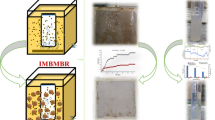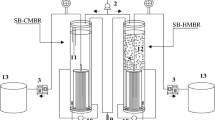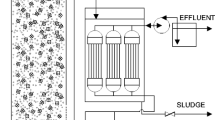Abstract
Membrane bioreactor (MBR) is relatively a new technology in wastewater treatment. It can efficiently remove soluble and suspended organics. However, it may constantly encounter bio-fouling and cannot efficiently remove nutrient pollutants. These two deficiencies have motivated researchers to upgrade the design and operation of conventional MBR (CMBR). This study evaluates the performance of hybrid fixed bed MBR (FBMBR) treating real domestic wastewater in different operational conditions. It also compares the experimental results of FBMBR with the CMBR. For this purpose, two identical reactors are constructed as CMBR and FBMBR. Each module contains the net volume of 140 L and is operated continuously in two aerobic (DO > 4 mg/L) and anoxic (DO < 1 mg/L) conditions with average organic loading rates (OLRs) of 0.58, 0.71 and 1.55 kgCOD/m3d. The pore sizes of flat sheet membranes are 0.2–0.8 μm with total surface area of 1.4m2 per module. The experimental results revealed that the removal efficiencies of BOD, COD and TSS are above 95 % in both CMBR and FBMBR in all operating conditions. However, fouling occurs with lower rates in FBMBR. The growing rate of transmembrane pressure (TMP) in aerobic condition is 1.7mBar/day in CMBR, while it reduces to 1.2mBar/day for FBMBR in solid retention time (SRT) of 75 days and OLR of 0.58 and 0.71 kgCOD/m3d. In anoxic condition with SRT of 100 days and OLR of 1.55 kgCOD/m3d, the TMP in FBMBR is 59 % of CMBR. In addition, total nitrogen (TN) removal is between 12 % (aerobic) and 27 % (anoxic) in CMBR, while it is between 25 % (aerobic) and 49 % (anoxic) in FBMBR. Total phosphorous (TP) removal also ranges between 50 and 66 % in CMBR, while it is between 51 and 86 % in FBMBR. Consequently, using hybrid systems of FBMBR can reduce membrane fouling rate and improve nutrient removal efficiency in comparison with CMBR. This approach can reinforce the biological treatment efficiency and preserve permeate quality in higher OLRs or in lower DO level.







Similar content being viewed by others
References
Akbarzadeh A, Jamshidi S, Vakhshouri M. Nutrient uptake rate and removal efficiency of Vetiveria zizanioides in contaminated waters. Pollution. 2015;1(1):1–8.
Alighardashi A, Pakan M, Jamshidi S, Shariati FP. Performance evaluation of membrane bioreactor (MBR) coupled with activated carbon on tannery wastewater treatment. Membr Water Treat. 2017;8(6):517–28. https://doi.org/10.12989/mwt.2017.8.6.517.
APHA. Standard methods for the examination of water and wastewater, 23rd ed. Washington DC: American Public Health Association; 2017.
Asif MB, Hai FI, Jegatheesan V, Price WE, Nghiem LD, Yamamoto K. Chap. 8 - Applications of membrane bioreactors in biotechnology processes Editor(s): Basile A. and Charcosset C., Current Trends and Future Developments on (Bio-) Membranes, Elsevier, 2019; p. 223–257.
ASTM D5907-18. Standard test methods for filterable matter (total dissolved solids) and nonfilterable matter (total suspended solids) in water. West Conshohocken: ASTM International; 2018.
Awan SF, Zhang B, Zhong Z, Gao L, Chen X. Industrial wastewater treatment by using MBR (Membrane Bioreactor) review study. J Environ Prot. 2015;6(6):584–98.
Bezirgiannidis A, Marinakis N, Ntougias S, Melidis P. Biological treatment of a low strength domestic wastewater in a membrane bioreactor. Eur Water. 2017;58:83–6.
Buha DM, Atalia KR and Shah NK. Continuous process study on simultaneous nitrification–denitrification of high ammoniacal nitrogen load wastewater in aerobic–anoxic sequencing bioreactors. Int J Environ Sci Technol 2017;14:2451–2458.
Cuevas-Rodríguez G, Cervantes-Avilés P, Torres-Chávez I, Bernal-Martínez A. Evaluation of different configurations of hybrid membrane bioreactors for treatment of domestic wastewater. Water Sci Technol. 2015;71(3):338–46.
Deng L, Guo W, Ngo HH, Zhang X, Wang XC, Zhang Q, Chen R. New functional biocarriers for enhancing the performance of a hybrid moving bed biofilm reactor–membrane bioreactor system. Biores Technol. 2016;208:87–93.
Ebrahimi M, Gholikandi GB, Jamshidi S, Ezzo H. Dolomite reactor, a retrofitting approach for activated sludge against bulking. Iran J Sci Technol Trans A Sci. 2018;42:1215–21. https://doi.org/10.1007/s40995-016-0120-x.
Gholikandi GB, Jamshidi S, Hazrati H. Optimization of anaerobic baffled reactor (ABR) using artificial neural network in municipal wastewater treatment. Environ Eng Manag J. 2014;13(1):95–104.
Goswami L, Kumar RV, Borah SN, Manikandan NA, Pakshirajan K, Pugazhenthi G. Membrane bioreactor and integrated membrane bioreactor systems for micropollutant removal from wastewater: A review. J Water Process Eng. 2018;26:314–28.
Gu Y, Huang J, Zeng G, Shi L, Shi Y, Yi K. Fate of pharmaceuticals during membrane bioreactor treatment: Status and perspectives. Biores Technol. 2018;268:733–48.
Gurung K, Ncibi MC, Sillanpa M. Assessing membrane fouling and the performance of pilot-scale membrane bioreactor (MBR) to treat real municipal wastewater during winter season in Nordic regions. Sci Total Environ. 2017;579:1289–97.
Habib R, Asif MB, Iftekhar S, Khan Z, Gurung K, Sillanpaa M. Influence of relaxation modes on membrane fouling in submerged membrane bioreactor for domestic wastewater treatment. Chemosphere. 2017;181:19–25.
Iorhemen OT, Hamza RA, Tay JH. Membrane Bioreactor (MBR) technology for wastewater treatment and reclamation: membrane fouling. Membranes. 2016;6:33.
Izadi A, Hosseini M, Darzi GN, Bidhendi GN, Shariati FP. Performance of an integrated fixed bed membrane bioreactor (FBMBR) applied to pollutant removal from paper-recycling wastewater. Water Resour Ind. 2019;21:100111.
Jamshidi S. Value-added innovation in infrastructure systems, lessons learned from wastewater treatment plants. TQM J. 2019;31(6):1049–63.
Judd SJ. The status of industrial and municipal effluent treatment with membrane bioreactor technology. Chem Eng J. 2016;305:37–45.
Khan SJ, Hasnain G, Fareed H, Aim RB. Evaluation of treatment performance of a full-scale membrane bioreactor (MBR) plant from unsteady to steady state condition. J Water Process Eng. 2019;30:100379.
Kitanou S, Tahri M, Bachiri B, Mahi M, Hafsi M, Taky M, Elmidaoui A. Comparative study of membrane bioreactor (MBR) and activated sludge processes in the treatment of Moroccan domestic wastewater. Water Sci Technol. 2018;78(5):1129–36.
Kwak W, Rout PR, Lee B, Bae J. Influence of hydraulic retention time and temperature on the performance of an anaerobic ammonium oxidation fluidized bed membrane bioreactor for low-strength ammonia wastewater treatment. Chem Eng J. 2020;386:123992.
Lin H, Zhang M, Wang F, Meng F, Liao BQ, Hong H, Chen J, Gao W. A critical review of extracellular polymeric substances (EPSs) in membrane bioreactors: Characteristics, roles in membrane fouling and control strategies. J Membr Sci. 2014;460:110–25.
Mahdavi SZ, Razavi SMR, Shirazian S. Mathematical modeling and simulation of nitrate separation from contaminated water in a membrane contactor. Iran J Sci Technol Trans A Sci. 2018;42:1223–31. https://doi.org/10.1007/s40995-016-0058-z.
Mannina G, Ekama GA, Capodicia M, Cosenza A, Trapani DD, Ødegaard H. Integrated fixed-film activated sludge membrane bioreactors versus membrane bioreactors for nutrient removal: A comprehensive comparison. J Environ Manag. 2018;226:347–57.
Miyoshi T, Tsumuraya T, Nguyen TP, Kimura K, Watanabe Y. Effects of recirculation and separation times on nitrogen removal in baffled membrane bioreactor (B-MBR). Water Sci Technol. 2018;77(12):2803–11.
Naderi Varandi B, Jamshidi S, Mennerich A, Sadeghi Azad A. Electrolysis enhanced anaerobic baffled reactor as retrofitting approach for molasses based distillery wastewater treatment. Desalin Water Treat. 2017;62:80–5. https://doi.org/10.5004/dwt.2017.20144.
Palmarin MJ, Young S. Comparison of the treatment performance of a hybrid and conventional membrane bioreactor for greywater reclamation. J Water Process Eng. 2019;28:54–9.
Park HD, Chang IS, Lee KJ. Principles of membrane bioreactors for wastewater treatment. Boca Raton: CRC Press; 2015.
Rodríguez-Hernández L, Esteban-García AL, Tejero I. Comparison between a fixed bed hybrid membrane bioreactor and aconventional membrane bioreactor for municipal wastewatertreatment: A pilot-scale study. Biores Technol. 2014;152:212–9.
Schmitt F, Banu R, Yeom IC, Do KU. Development of artificial neural networks to predict membrane fouling in an anoxic aerobic membrane bioreactor treating domestic wastewater. Biochem Eng J. 2018;133:47–58.
Valipour A, Taghvaei SM, Raman VK, Gholikandi GB, Jamshidi S, Hamnabard N. An approach on attached growth process for domestic wastewater treatment. Environ Eng Manag J. 2014;13(1):145–52.
Wang L, Li B, Li Y, Wang J. Enhanced biological nitrogen removal under low dissolved oxygen in an anaerobic-anoxic-oxic system: Kinetics, stoichiometry and microbial community. Chemosphere. 2021;263:128184.
Xiao K, Liang S, Wang X, Chen C, Huang X. Current state and challenges of full-scale membrane bioreactor applications: A critical review. Biores Technol. 2019;271:473–81.
Zeeshan M, Haydar S, Tabraiz S. Effect of fixed media surface area on biofouling and nutrients removal in fixed film membrane bioreactor treating sewage at medium and high fluxes. Water Air Soil Pollut. 2017;228:377.
Zhang W, Tang B, Bin L. Research progress in biofilm-membrane bioreactor: a critical review. Ind Eng Chem Res. 2017;56(24):6900–9.
Zheng Y, Zhang W, Tang B, Ding J, Zheng Y, Zhang Z. Membrane fouling mechanism of biofilm-membrane bioreactor (BF-MBR): pore blocking model and membrane cleaning. Biores Technol. 2018;250:398–405.
Author information
Authors and Affiliations
Corresponding author
Additional information
Publisher’s note
Springer Nature remains neutral with regard to jurisdictional claims in published maps and institutional affiliations.
Rights and permissions
About this article
Cite this article
Khastoo, H., Hassani, A.H., Mafigholami, R. et al. Comparing the performance of the conventional and fixed‐bed membrane bioreactors for treating municipal wastewater. J Environ Health Sci Engineer 19, 997–1004 (2021). https://doi.org/10.1007/s40201-021-00664-3
Received:
Accepted:
Published:
Issue Date:
DOI: https://doi.org/10.1007/s40201-021-00664-3




